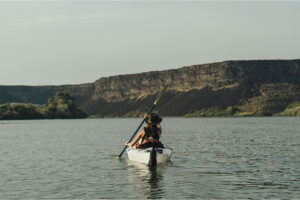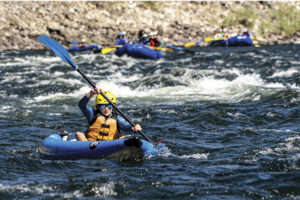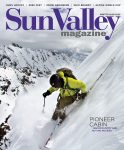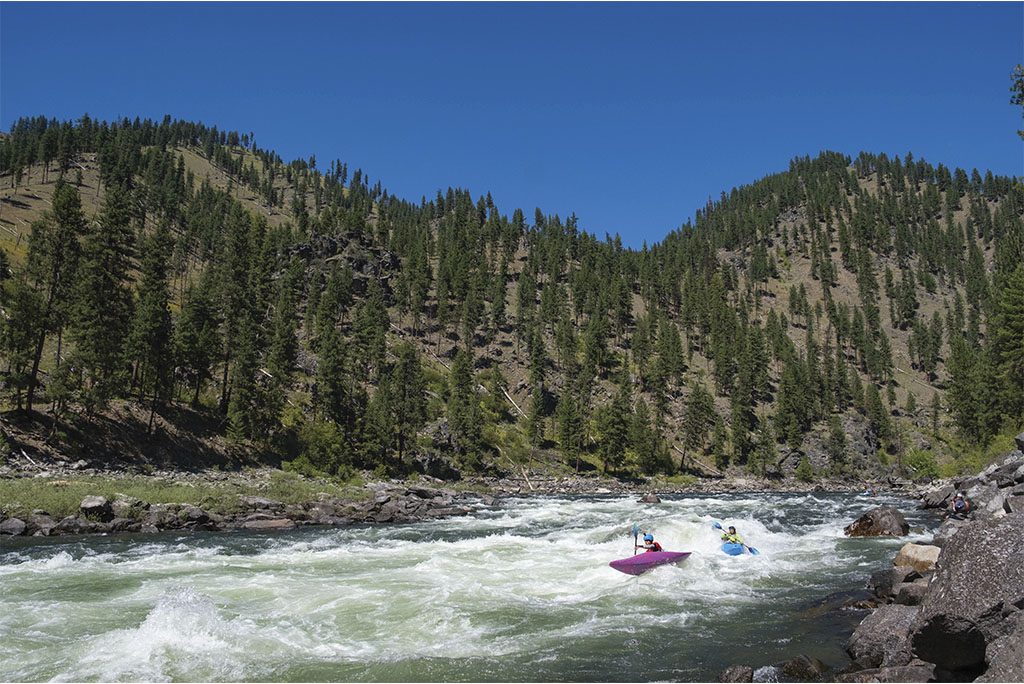The history of modern kayaking, as we know it, started in 1811, when a group of travelers set out to kayak the Snake River in Wyoming (yes, that same Snake River that crosses our own state) but ultimately backed out after finding the rapids too rough for their equipment and skill set. From there, more people became interested in floating these vessels down the rivers of the West. Fast-forward to the 1940s, when the use of fiberglass and aluminum to craft kayaks and canoes grew the sport’s popularity, with one man, in July 1940, launching the first commercial whitewater trip through the Snake River Canyon, led by a veteran riverman on the Salmon River.
Whether your craft is a raft or a kayak, there’s no denying that Idaho is home to some world-class whitewater—so much so that it is known as the “white water state” among river rats. Idaho is home to 3,100 navigable whitewater miles, the most of any state in the Lower 48. And if whitewater isn’t your scene, Idaho is also home to more than 2,000 lakes, the perfect setting for those looking to paddle calmer waters.

The great aspect of kayaking is that you can either go big on rapids or relax on chill waters.
The Basics
There are two kinds of kayaks: hard-shell and inflatable. Inflatable kayaks have many benefits, starting with their ability to pack down tightly for storage. They are more suited for recreational use, like paddling in calm waters or fishing. They tend to be wider, making them more stable, and they’re also easy to clean and maintain. Hard-shell kayaks are extremely durable and sit deeper in the water (and therefore track better), making them more suited for rougher waters.
If you’re new to kayaking or need a refresher, there are several spots that teach kayaking lessons, though none within the Wood River Valley. Head up to Stanley to visit White Otter for either their private kayak lessons or to enroll in their kayak school (available for both adults and kids). Kayaks are available to rent, and private lessons (taught on the Upper Salmon) run half-day or full-day, are customizable, and are capped at two participants. For more immersive learning, White Otter offers a four- or seven-day kayak school for beginner or intermediate kayakers with a small group on the Salmon River.
For those who want to practice their kayak roll (an essential safety skill for any kayaker), the Wood River YMCA offers 1.5-hour kayak open pool sessions by reservation for an extra charge, though no instruction is provided.
Renting a Kayak
For those not ready to commit to owning a kayak just yet, there are several local areas to rent. Black Tie Adventure Rentals in Ketchum rents inflatable kayaks for $75 for one day and $50/day for multiple days, which you can pick up at their shop or have delivered to your lodging or hotel.
Backwoods rents hard-shell and inflatable kayaks for full or multi-days.
Silver Creek Kayaks rent kayaks to float Silver Creek Preserve or the Little Wood Reservoir; you can also book shuttle service to and from those locations. Sun Valley Resort rents kayaks on Sun Valley Lake for $45 per hour. Redfish Lake rents single or double kayaks at one-hour, half-day (four hours), and full-day (eight hours) rates. Depending on your destination, multiple rental spots exist in the Twin Falls, Boise, and Stanley areas.
Where to Go
When deciding where to kayak, there are two types of water to consider: whitewater or calm water. Idaho has plenty of both; generally, if you can raft or boat on it, you can kayak on it. For local, calmer waters, try the Silver Creek Preserve south of Bellevue, the Hulen Meadows pond, Sun Valley Lake, or the Little Wood Reservoir, ten miles north of Carey. Magic Reservoir has several different access points, all leading to great boating waters. Head to Twin Falls to paddle Dierkes Lake, Centennial Waterfront Park, Shoshone Falls, or Pillar Falls (or a combination of these for a longer paddle). Spots near Twin Falls, like the Snake River near Hagerman or Lake Cleveland near Albion, are also worth checking out.
Kayaking around a gorgeous alpine lake is a must-do, so head north and launch on Alturas, Petit, Red Fish, or Stanley Lakes. If you find yourself in the Boise area, try kayaking in Lucky Peak State Park or get in some practice on the manmade waves of the Boise Whitewater Park.
For those looking to start practicing on rivers and work their way up to rougher white water, some intermediate waters are perfect to try out. Sun Valley’s own Bigwood River varies from beginner to advanced, depending on the time of year, the height of the water, and the number of downed trees in the water. The Boise River has mostly mellow waters, with three small drops in the river and several curves that require light navigation that will test your kayaking knowledge. The portions of the Salmon River in Stanley are also considered intermediate (Class II and III).
For advanced and expert kayakers, Idaho’s biggest draws are the big guns, like the Lower, Middle, and Upper Salmon River, the South Fork of the Payette and Hells Canyon of the Snake River.

Book a Trip
If planning a multi-day kayaking trip is more work than you’re looking for, several companies in the area offer preplanned kayaking trips. Sawtooth Adventure Company, based in Stanley, offers daily inflatable kayak trips from June 1 through September 2. No experience is necessary for these trips that run $90 (without lunch) or $125 (with lunch). Wilderness River Outfitters, based in Salmon, offers six hard-shell kayaking trips: Jarbridge-Bruneau, Lower Salmon, Main Salmon, Middle Fork Salmon, Middle Fork Flathead, and Owyhee, varying in price, season, and adventure level. Hard-shell kayaks are available to rent if you don’t own them, and inflatable kayaks are also available for their other river trips. The River Company in Stanley offers daily day trips on class I, II, III and IV rapids via inflatable kayak from June through August.
Classes of Rapids
Class I is fast-moving water with small waves
Class II involves wide, clear channels that are easy to maneuver
Class III has moderate, irregular waves that can be difficult to avoid
Class IV is for advanced rafters
Class V involves violent rapids that are long and obstructed
Class VI is the highest level


